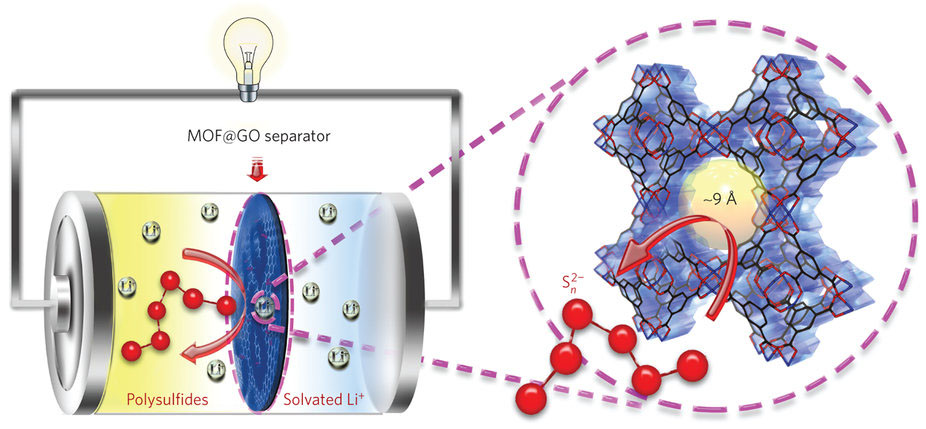Research Abstract
リチウム硫黄電池のための金属有機構造体を用いたセパレーター
Metal–organic framework-based separator for lithium–sulfur batteries
2016年6月27日 Nature Energy 1 : 16094 doi: 10.1038/nenergy.2016.94

リチウム硫黄電池は、比較的安価で理論的なエネルギー密度が高いため、エネルギー貯蔵技術として有望である。しかし、可溶性多硫化物の電極間でのシャトリングによる急速な容量の劣化が、大きな技術的課題の1つとなっている。今回我々は、シャトリング問題を抑制するための、金属有機構造体(MOF)を用いた電池セパレーターを提示する。我々は、MOFを用いたセパレーターが、リチウム硫黄電池でイオンふるいとして機能し、Li+イオンを選択的にふるい分けるとともに、アノード側への多硫化物の望ましくない移動を効率的に抑制することを示す。硫黄を含むメソ多孔質炭素材料(硫黄含有量約70 wt%)を複雑な合成や表面改質を行わずに複合カソードとして用いた場合、MOFをセパレーターとして利用するリチウム硫黄電池は低い容量減少率(1,500サイクル以上にわたって1サイクルあたり0.019%)を示した。さらに、初期の100サイクル以降は容量の劣化がほぼなかった。今回の方法は、エネルギー貯蔵用途のセパレーターとしてのMOF系材料の可能性を実証するものである。
Corrsonding Author
Lithium–sulfur batteries are a promising energy-storage technology due to their relatively low cost and high theoretical energy density. However, one of their major technical problems is the shuttling of soluble polysulfides between electrodes, resulting in rapid capacity fading. Here, we present a metal–organic framework (MOF)-based battery separator to mitigate the shuttling problem. We show that the MOF-based separator acts as an ionic sieve in lithium–sulfur batteries, which selectively sieves Li+ ions while efficiently suppressing undesired polysulfides migrating to the anode side. When a sulfur-containing mesoporous carbon material (approximately 70 wt% sulfur content) is used as a cathode composite without elaborate synthesis or surface modification, a lithium–sulfur battery with a MOF-based separator exhibits a low capacity decay rate (0.019% per cycle over 1,500 cycles). Moreover, there is almost no capacity fading after the initial 100 cycles. Our approach demonstrates the potential for MOF-based materials as separators for energy-storage applications.

